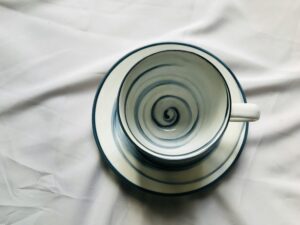Coffee is more than just a beverage; it’s a cultural experience that connects people across the globe. From the bustling coffee houses of Istanbul to the serene coffee ceremonies of Ethiopia, each culture has its own unique way of enjoying this beloved drink. But how do these global coffee traditions differ, and what makes them so special?
Table of Contents
In this blog, we will take you on a journey around the world, exploring some of the most fascinating coffee traditions. Whether you’re a coffee enthusiast or simply curious about global cultures, these traditions are sure to inspire you to broaden your coffee horizons.
1. Ethiopian Coffee Ceremony: A Sacred Ritual
Let’s start our journey where it all began—Ethiopia, the birthplace of coffee. Coffee here is not just a drink; it is a sacred ritual. The Ethiopian coffee ceremony is a social and spiritual experience that can last for hours.
How It’s Done:
- Preparation: Green coffee beans are washed and roasted in a pan over an open flame. The aroma fills the room, and guests take a moment to inhale the rich, smoky scent.
- Grinding and Brewing: The roasted beans are ground using a mortar and pestle and then brewed in a special pot called a jebena.
- Serving: The coffee is poured into small cups without a filter, often flavored with salt, butter, or traditional spices.
Why It’s Special:
The ceremony is about more than just drinking coffee—it is a time for community bonding, storytelling, and reflection.
Try It Yourself:
To experience this tradition at home, consider buying Ethiopian coffee beans and brewing them in a jebena. Invite friends over, and make it a social experience.
2. Turkish Coffee: The Art of Fortune Telling
Next, we travel to Turkey, where coffee is an art form and a symbol of hospitality. Turkish coffee is known for its strong, rich flavor and the thick layer of coffee grounds that settle at the bottom of the cup.
How It’s Made:
- Brewing: Finely ground coffee is simmered in a special pot called a cezve, along with water and sugar, over low heat. It is never stirred once it starts brewing.
- Serving: The coffee is poured into a small cup without straining, leaving the thick grounds at the bottom.
- Fortune Telling: After drinking, the cup is turned upside down onto a saucer, and the patterns left by the grounds are used to tell fortunes.
Why It’s Special:
In Turkey, coffee is a symbol of friendship and hospitality. Offering coffee is a gesture of kindness, and reading fortunes is a fun way to bond with friends.
Try It Yourself:
Get a cezve and some finely ground Turkish coffee. Brew it slowly, and don’t forget to try your hand at fortune-telling—who knows what the grounds might reveal?
Quality Turkish Coffee Pot

3. Italian Espresso Culture: A Quick Delight
Our next stop is Italy, home of the iconic espresso. Italians are serious about their coffee, and their approach is fast, strong, and full of flavor.
How It’s Done:
- Brewing: Espresso is made using a high-pressure machine that forces hot water through finely-ground coffee, resulting in a small, concentrated shot.
- Tradition: Italians often drink their espresso standing at the bar, a quick shot before heading to work or between meetings.
- Varieties: In Italy, you can enjoy a wide range of espresso-based drinks, such as macchiato, cappuccino, and latte.
Why It’s Special:
Espresso is more than just a drink in Italy—it is a way of life. It is fast, strong, and energizing, perfectly suited to the Italian lifestyle.
Try It Yourself:
Invest in an espresso machine or stovetop moka pot. Learn to make a perfect shot, and enjoy it the Italian way—quickly and with passion.
4. Vietnamese Egg Coffee: A Sweet Indulgence
We now head to Vietnam, where coffee takes on a sweet and creamy twist with the famous egg coffee (cà phê trứng). This unique drink is a blend of strong Vietnamese coffee and a creamy, sweet egg mixture.
How It’s Made:
- Brewing: Strong Vietnamese coffee is brewed using a traditional phin filter.
- Egg Mixture: Egg yolks are whipped with sweetened condensed milk and sometimes vanilla until thick and creamy.
- Combining: The creamy egg mixture is poured over the hot coffee, creating a delicious, custard-like topping.
Why It’s Special:
Egg coffee is both a drink and a dessert, offering a rich and indulgent experience. It originated in Hanoi during a milk shortage, but its unique flavor has made it famous worldwide.
Try It Yourself:
Use a phin filter to brew strong coffee and carefully whip the egg mixture. Pour it over your coffee and enjoy this sweet, creamy delight.
5. Scandinavian Kaffeost: Coffee with Cheese
Our journey takes an unexpected turn in Scandinavia, where coffee is enjoyed with a surprising addition—cheese. This tradition, known as kaffeost, is popular among the Sami people of northern Finland and Sweden.
How It’s Done:
- Brewing: Strong, hot coffee is brewed as usual.
- Serving: Cubes of leipäjuusto (bread cheese) are placed in the bottom of a cup, and hot coffee is poured over them.
- Enjoying: The cheese becomes soft and slightly chewy, providing a unique texture contrast to the coffee.
Why It’s Special:
Kaffeost is a cozy, comforting drink, perfect for cold Scandinavian winters. It is both a drink and a snack in one.
Try It Yourself:
Find some leipäjuusto or a similar cheese, and pour freshly brewed coffee over it. Let the flavors and textures surprise you.
6. Saudi Arabian Qahwa: A Spice-Infused Delight
Our final stop is the Middle East, where we experience Saudi Arabian Qahwa, a spiced coffee served with dates. This is a symbol of hospitality in Saudi culture.
How It’s Made:
- Brewing: Lightly roasted coffee beans are brewed with spices like cardamom, cloves, and saffron.
- Serving: The coffee is served in small, handleless cups called finjaan, often accompanied by sweet dates.
- Hospitality: Offering qahwa to guests is a mark of generosity and hospitality.
Why It’s Special:
Qahwa’s unique spiced flavor is a sensory experience, and the act of serving it is a symbol of warmth and friendship.
Try It Yourself:
Brew light roast coffee with cardamom and saffron. Serve it in small cups, and enjoy with dates for an authentic experience.
Frequently Asked Questions (FAQs)
Q1: What is the oldest coffee tradition in the world?
A1: The Ethiopian coffee ceremony is considered one of the oldest coffee traditions, as Ethiopia is the birthplace of coffee.
Q2: What makes Turkish coffee unique?
A2: Turkish coffee is brewed without filtering, creating a thick, rich coffee with grounds at the bottom. It is also famous for the fortune-telling tradition.
Q3: Can I recreate these global coffee traditions at home?
A3: Absolutely! With the right ingredients and tools, you can experience these amazing global coffee traditions in your own kitchen.
Q4: Is egg coffee safe to drink?
A4: Yes, Vietnamese egg coffee is made with fresh eggs, which are whipped into a creamy mixture. It is delicious and safe when prepared properly.
Conclusion: A World of Coffee Awaits
Exploring global coffee traditions is a journey of flavor, culture, and history. From the community-focused Ethiopian coffee ceremony to the indulgent sweetness of Vietnamese egg coffee, each tradition offers a unique experience. So why not bring these traditions to your own home? Try them, share them with friends, and discover the world of coffee in your own kitchen.






